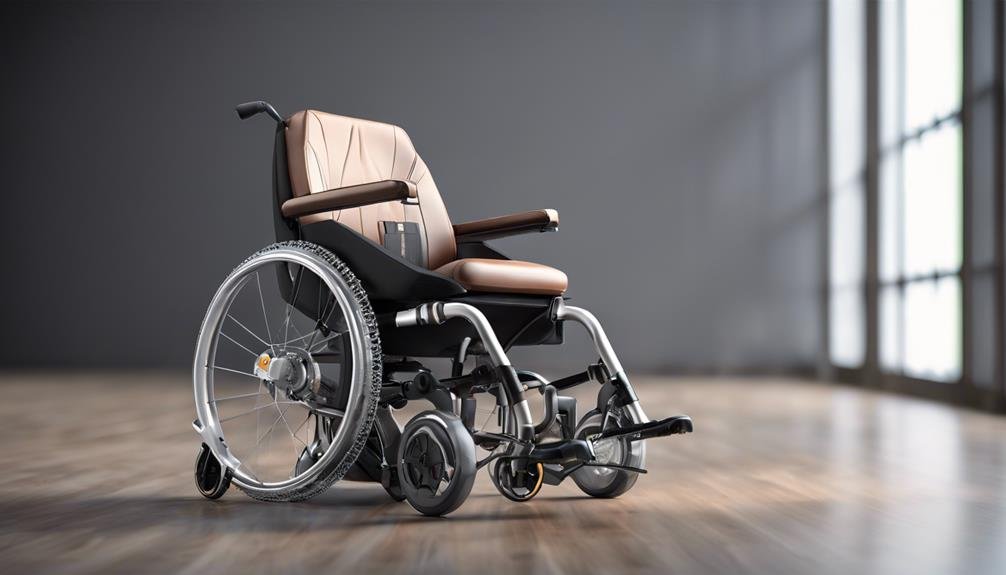Wheelchair Innovations Review: Enhancing Mobility With Technology
Experience revolutionary wheelchair technology advancements that enhance mobility through advanced sensors, remote control operation, and automatic adjustments for safety. Enjoy lightweight, foldable designs for portability and compact storage, promoting independence and ease of transportation. Explore enhanced navigation systems with voice-controlled assistance and augmented reality guidance, revolutionizing maneuvering in diverse environments. Discover innovative materials like carbon fiber and titanium alloy, ensuring durability, functionality, and comfort for users. Benefit from connectivity features allowing control through smartphones, customized settings, and proactive maintenance. Unprecedented ease, safety, and accessibility await with these cutting-edge innovations.
Key Takeaways
- Smart Wheelchair Technology enhances independence and safety with advanced sensors and remote control operation.
- Lightweight and Foldable Designs benefit mobility, portability, and storage convenience for an independent lifestyle.
- Enhanced Navigation Systems offer voice-controlled assistance and augmented reality for seamless maneuvering in diverse environments.
- Innovative Materials and Construction prioritize durability, functionality, and comfort using advanced materials like carbon fiber and memory foam.
- Connectivity and Accessibility Features improve user experience, customization, and proactive maintenance through digital connectivity.
Smart Wheelchair Technology
When moving through complex environments, smart wheelchair technology enhances your independence and safety by integrating advanced sensors and automated features. One key aspect of this technology is the ability for remote control, allowing you to operate the wheelchair from a distance when needed. This feature is particularly useful in situations where you may need assistance or when maneuvering through tight spaces becomes challenging.
Additionally, smart wheelchairs offer automatic adjustments based on the user's surroundings. For example, the wheelchair may automatically adjust its speed when approaching obstacles to prevent collisions, or it could modify its seat position for best comfort and posture support. These automatic adjustments not only enhance your overall experience but also contribute to a safer and more efficient mobility solution.
Lightweight and Foldable Designs
Have you ever considered the benefits of lightweight and foldable designs in wheelchair innovation? When it comes to enhancing mobility, portability solutions and ergonomic features play an important role. Manufacturers are focusing on creating wheelchairs with user-friendly adjustments that cater to individual needs while ensuring ease of use. These lightweight designs make transportation hassle-free, allowing users to navigate through various environments with greater convenience.
Incorporating foldable designs into wheelchairs not only enhances portability but also enables compact storage when not in use. Imagine the convenience of being able to fold your wheelchair effortlessly to fit into tight spaces or the trunk of a car. These ergonomic features not only benefit users from a practical perspective but also contribute to a more independent lifestyle.
Enhanced Navigation Systems
Enhancing the user experience further, wheelchair innovations now focus on integrating advanced navigation systems, revolutionizing how individuals maneuver through diverse environments with precision and ease. Voice controlled assistance plays a pivotal role in this advancement, allowing users to navigate their wheelchairs effortlessly by using simple voice commands. This feature not only enhances accessibility but also provides a hands-free experience, empowering individuals with limited mobility.
Moreover, the integration of augmented reality takes navigation to a whole new level. By overlaying digital information onto the physical environment, users can receive real-time guidance, location details, and even interactive elements to assist them in reaching their destinations more efficiently. This seamless blend of technology with mobility devices not only increases independence but also opens up new possibilities for exploring and interacting with surroundings.
Innovative Materials and Construction
Utilizing cutting-edge materials and construction techniques, wheelchair innovations are pushing boundaries to enhance durability, functionality, and comfort for users. Manufacturers are focusing on creating wheelchairs that are not only essential but also provide superior ergonomics for a comfortable user experience.
Innovative Materials and Construction play a vital role in the design and development of modern wheelchairs. Check out the table below for a glimpse into some of the materials and construction techniques revolutionizing wheelchair technology:
| Material | Construction Technique |
|---|---|
| Carbon Fiber | Modular Design |
| Titanium Alloy | Ergonomic Frame |
| Memory Foam | Lightweight Components |
| Kevlar Reinforcement | Adjustable Seating |
| Aluminum Alloy | Impact-Resistant Coatings |
These materials and construction methods contribute to the durability and comfort of wheelchairs. Carbon fiber and titanium alloy offer exceptional durability, while memory foam provides added comfort. Kevlar reinforcement enhances durability, and aluminum alloy ensures lightweight yet sturdy construction. The incorporation of these innovative materials and construction techniques is revolutionizing the wheelchair industry, prioritizing both durability and comfort for users.
Connectivity and Accessibility Features
How do connectivity and accessibility features in modern wheelchairs enhance user experience and functionality?
Digital connectivity has revolutionized the way wheelchairs operate, allowing users to control various functions through smartphones or tablets. This feature enables individuals to adjust settings like speed, seat position, and lighting with ease, providing a tailored and personalized experience.
Moreover, remote monitoring capabilities have greatly improved wheelchair maintenance and user safety. Through remote monitoring systems, caregivers and technicians can track the wheelchair's performance in real-time, receive alerts for maintenance needs, and even locate the device if misplaced. This not only guarantees that the wheelchair remains in excellent condition but also offers peace of mind to users and their families.
Incorporating digital connectivity and remote monitoring features into wheelchairs enhances accessibility by promoting independence, customization, and proactive maintenance. By leveraging these technologies, modern wheelchairs aren't just mobility aids but smart devices that empower users to navigate their environment with confidence and convenience.
Conclusion
You've now explored the latest wheelchair innovations that are revolutionizing mobility for those with disabilities. From smart technology to lightweight designs, these advancements are truly game-changers in enhancing independence and accessibility.
With these cutting-edge features, moving through the world is becoming easier than ever before. So, don't be left in the dust – jump on the bandwagon and experience the world through a whole new lens!







